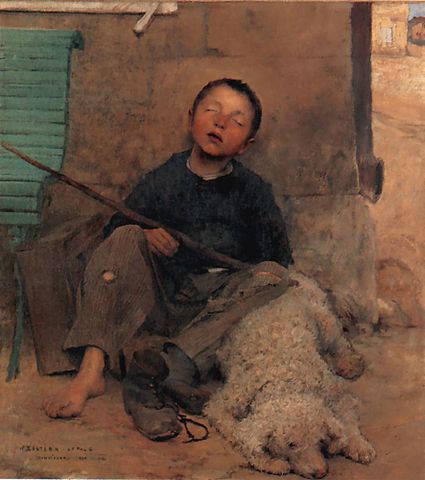I feel
exhaustion from time to time when things do not go as smoothly as I presumed
them to be, and that exhaustion might be coupled with weariness when in nervous
anticipation of something bad afoot. It is principally a physical exhaustion
that influences psychological listlessness. In paintings, exhaustion is not
merely represented by whirls and swirls- a sensation I often clichely correlate
to Hitchcock’s Vertigo- but it can
also appear as a transient moment of rapture: when one is exhausted the head
grows fuzzy, and gradually the body is levitated. Bearing in my mind now is a
picture of a decadent beauty, made wearied by strings of engagements and
courtships day and night, eyes constantly bleary and heavy-lidded. Exhaustion
turns into sultriness, which is like wisps of smoke lingering in the air.
The Pre-Raphaelite
beauty is one that seems invariably indolent and lackadaisical, weighed down by
the labour of god-knows-what. One can only probe into the character’s mentality
to discover what is really bothering her. In John Everett Millais’ Mariana (1851) it is obvious that
worries and woes burden the heroine’s heart so, as made manifest by her
positioning before the window, waiting presumably for the homecoming of her
enamoured one. But as yet another day of disappoint goes by the impatience and
anxiety of Mariana are revealed in her body language: stretching her back
fitfully and wilted leaves scattering the room- the sign of long suffering that
makes one bored and indifferent to the domestic matters that were once so
indispensible. The painting is based on Shakespeare’s Measure for Measure, in
which the heroine, amidst the excited preparation for her wedding, is cruelly
rejected when her dowry is sunk together with a shipwreck. Mariana is not
waiting for her beau but witnessing wearily the lost of her fortune and
happiness.
If only
exhaustion can transform into something more sublime, as mentioned earlier the
levitation opens a pathway of communicating with God. It is not exactly
exhaustion that Jules
Bastien-Lepage, in his painting The Blind
Beggar, depicts, but simply a poor blind boy begging for a morsel of food. It
could be that the boy was taking his daily respite, seeing that his furry
companion beside him is all consumed by slumber. Blindness can thus serve as a
disguise which situates in the twilight zone between alertness and
unconsciousness. In this case the blind boy is easily passed as a shaman- the
one who boasts connection with God but not insentient of the pain and travails
of human being.
The earthly
beings need hardly to ennoble their indolence as a sublime asset, but some of
them do not flinch from indulging themselves in protracted inactivity, lounging
everywhere from the beach to the park, where everything is basked in the hazy
sun and days are thus uneventfully frittered away. Gustave Courbet, a French
realist who created some of the most horrific paintings I’ve ever seen, shows
us such bourgeois delight in Les
Demoiselles au bord de la Seine (1857). Those ladies in the painting dress
rather elaborately. I wonder whether that impatient frown of the one in the
back bespeaks her displeasure of having her ritzy get-up hidden under the
shades of the thicket instead of admired by a band of suitors. Her friend is
obviously more contented with the siesta, her hands caressing the wild
plantation, and hogging the attention with her sultry gaze that seems more apt
in a sleazy jazz club.
Exhaustion,
weariness, indolence, listlessness, ennui… These emotions are like a sky free
of clouds and other natural happenings. It is often when gazing at a sky like
this- one with infinite clearness and cleanness- that I feel a lurking sense of
apprehension. It is like waiting for a flash of thunderbolt that galvanizes
every living thing under the firmament and incites the vigour that long lays
dormant. And it is when, ultimately, extreme emotions erupt.



Comments
Post a Comment